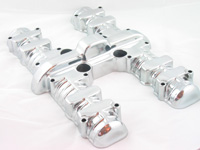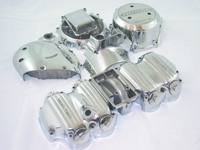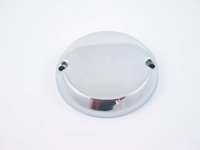Polishing Advice...
Problems
Polishing wheels used by professionals have sufficient torque. The piece will not stall against the polishing wheel. Mops used by professionals are large and have a high peripheral speed, which enables the polish soap to operate at cool temperatures.
Amateur polishing kits run hot causing soap to melt on the surface {'snot' in the trade}.
Polish techniques vary. It is usual to polish in two planes, ninety degrees apart.
Never press on. Pressing on generates heat, which is the enemy of everything in engineering. Aluminium scorches easily and will not colour up when burnt.
Recommendations
Mirror is the preferred choice of custom builders. Sisal is the preferred choice of those involved in vintage restoration.
Hubs
Never polish a hub spool edge unless it is in appalling condition. Spoke holes elongate and look elliptical. The spool edge will also get thinner.
Fork legs
Fork legs are the most likely casting to suffer from white oxidation because the veneer has been polished away. Consider grease belt linish as a finish followed by lacquer
Polishing
The surface of metal is uneven. Viewed through a microscope the surface is a multitude of peaks and troughs. This is known as the contour lean average (CLA).
Removing metal from the peak down to the trough approaching zero reduces the contour lean average. Light is reflected easily and gives a mirror finish. Removing less from the peaks and troughs will give a bright surface, which will diffuse light. This is known as a sisal finish.


Manufacturers do not mirror polish aluminium. They choose sisal for a good reason.
The external surface of new aluminium is dense and is referred to as a veneer. Attempting mirror finish will reduce the sharpness of the defined edges and wear away the veneer.
A metal polisher does not have the luxury of a new casting. They are forced into four stage finishing which can result in a loss of definition particularly if the object has been finished before. In some cases the dense veneer has been worn away exposing the microscopic air bubbles within the piece and white oxidation will grow on the surface.


There are two main categories of polish commonly available. These are known as mirror, and sisal. For your information mirror finish is achieved with a cotton mop, sisal with a rope mop. Both mops can be dressed with differing grades of composition which is often called soap
Mirror and sisal polishing
Mirror and sisal polishing has four stages. These are described below.
1. Pre-clean internally and externally using mild acids, vapour blasting and ball burnishing to remove oxidation, resins and oil stains. Clean castings prevent cross over contamination. Missing out this stage and attempting to clean using the wheel will transfer contaminants to the mop and result in a less reflective finish.
2. Scratches are removed using a 320 grade linish belt coated with soap. The belt runs on a back idler. Coarse belts introduce fine scratches. The depth of the scratch determines the area and amount of aluminium to be cut away.
3. All of the casting is sateen polished using a mop and compound. Compound is not the same as composition. Sateen gives the appearance of brushed aluminium.
4. Final finishing is known in the trade as colouring up. “Colouring up” is done with a cotton mop and soap when a mirror finish is required. Lime powder removes polish blobs and finger marks.
Interpretation of the finish is dependent upon the eye of the polisher. Steel and aluminium differ in hardness and compositions with more or less grease will be used.



